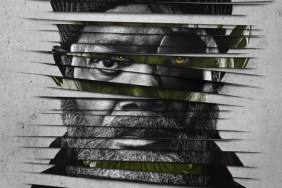
Lee Gambin’s “Secretly Scary” column continues to look at non-horror films that are secretly horror films!
And he rammed the fear of God into me so fast, I never heard my old mans footsteps
Lulu Baines (Shirley Jones)
Based on Sinclair Lewiss acclaimed novel about rampant rabid hypocrisy in religion and the despicable corruption of the church, ELMER GANTRYis a masterwork that deserves not only recognition for its gripping honesty, but a complete re-reading as a devastatingly manic horror film that sets out to cut the jugular and expose detestable truths about the human condition. From its opening title sequence designed by the innovative and story-obsessive Saul Bass and accompanied by the driving creepy score by maestro Andre Previn, director Richard Brooks delivers a confronting and harrowing movie experience that dissects the monstrousness of opportunists and plays with the evils that influence the morally bankrupt and insincere.
The novel opens with the line: Elmer Gantry was drunk; and here in the film this megalomaniac Lothario who smells of a combination of booze and women, sits in a dark bar hollering and wildly screaming out indecencies. When confronted by two meek young women collecting for their local church, he takes up their position and conducts an impromptu sermon, forcing drunken heathens and non-believers to hand over their bucks. From this early moment, a monster is born. The sweet talking, charismatic devil that is Elmer Gantry embarks on a new opportunity to take advantage of the masses by channeling in a phony religious zeal and becoming a feverish preacher.
Burt Lancaster is a towering giant with a presence that unsettles and strategically manipulates. There is hostility in his charm, a sickening undercurrent in his outstretched arm offering welcome and a violent outburst waiting to erupt just under the surface. Here is a hysterical, frenzied charlatan who dances in and out of demonic merriment – and with his bravado and ruthless sex appeal he plows through the insecurities and anxieties plaguing those that meet him upon his supposedly worthy path. The most influential individual he meets is the hyper-charismatic and almost otherworldly Sister Sharon Falconer, a revivalist preacher modeled on the real life vaudevillian superstar Sister Aimee Semple McPherson (a controversial religious leader that had an extraordinary, almost supernatural life).

Jean Simmons as Sister Sharon Falconer is hypnotizing to watch and completely psychotic in her devotion to her cause. Her introduction to the film is akin to a freak show at a circus as she walks past her dedicated congregation and addresses them with a chirpy assertiveness shouting out the wonders of Gods miracles in this case, milk is used as an example. When she sifts through the crowd and meets her adoring fans, she is taken aback by Lancasters Elmer Gantry who is smitten, and begins his ultimate seduction which revs up the film into its core story arc: the coming together of two monsters, a man who lies and cheats his way through the rich pastures of opportunity and a woman who lives as though she is the second coming.
Some vivid and striking imagery comes thick and fast in this controversial motion picture such as the moment where Gantry (now a rival/cohort to Falconer) encourages a devotee to insanely bark like a dog to prove his commitment to God (a terrifying sequence to rival any werewolf outing), a bizarre entry where Gantry shares the stage with a chimpanzee to dispel the idea of evolution, the sinister depiction of Gantrys successful seduction/rape of Sister Sharon Falconer on the beachfront that hosts her newly developed church and the harrowing closing moments that inspired the destruction of the prom in Brian De Palmas horror opus CARRIE (1976). Here, Falconer caught in a deadly blazing fire that brings her church to the ground becomes the Angel of Death wailing and screaming to her congregation to Stay and Trust in the Lord for He will save you! Much like Piper Laurie as the abusive religious zealot in CARRIE, Jean Simmons is terrifying as the shrieking willowy preacher who denies the pleasures of hedonism. Even after letting herself fall in love with Elmer Gantry (summed up by a superb shot of her spilling sand from her shoe, smiling like the cat that got the cream) Falconer is purely enthusiastic for her Lord and dies for His word. The violence of the sequence, and the hysteria is akin to any climactic moment in a horror film that closes with its monster wreaking frightening havoc.
Rounding out this phenomenal and important film, the remarkable Shirley Jones co-stars as Lulu Baines, a hardened prostitute who was once a lover of Gantrys. After Gantry threw her to the sidelines, Baines fell into sex work and lost herself to a vortex of loneliness, displacement and emptiness. When Gantry makes the newspapers and becomes the savior of the morally righteous, Baines decides to sabotage his position and sets out to destroy this horrendous charlatan. Much like a Universal horror film, Elmer Gantry leads a mob of angry villagers (complete with flaming torches) to close down the brothels and ridding good America of its social ills. One of these brothels happens to be the sin-bin that Lulu Baines works at and so begins the juicy subplot of this decedent and disturbing film. Shirley Jones is outstanding (winning the Best Supporting Actress Oscar for her performance) as the tough talking but ultimately vulnerable prostitute, who turns out to be the archetypal whore with the heart of gold. When she watches a disgruntled mob turn on the outed morally bankrupt Gantry she feels for him and is soiled by the mess (the fruits and vegetables thrown end up also hitting her) and when she is beaten by her pimp it is heartbreaking to watch this complicated unfortunate damaged by the Christian moralistic brigade.
Director Richard Brooks would make a career out of provocative and dark subject matter, one of these would be the distressing LOOKING FOR MR. GOODBAR (1977) – a bleak outing, which fundamentally summarizes the seventies grit that took over Hollywood during the period. ELMER GANTRY was released at the dawn of the decline of the Production Code, and although the censors had massive issues with the content, it does manage to speak the dirt and scare the audience into questioning the pretense of religion.
An early 70s musical adaptation directed by choreographer Onna White (OLIVER!) and starring Robert Shaw (JAWS) as Gantry and Rita Moreno (WEST SIDE STORY) as Falconer hit the Broadway stage for a total of one night and closed right after, while an opera fared better in the 1990s. As captivating as the stage adaptations were, ELMER GANTRY as a film is a mesmerizing masterpiece of menace and manic distress. It also does something with its narrative choices that surpasses the novel in that it takes the strongest component from the book (that is the unholy union shared between its protagonist and Sister Sharon Falconer) as its core and drives the emotional beats home. Lancaster and Simmons share some sizzling screen time and their shaky and emotionally tortured and doomed romance is unnerving and frightening to watch. The truly harrowing moments come quietly, where characters are emotionally raped, drained and damaged and this is what ELMER GANTRY does best, it captures the human condition, mutilates it and transforms it into something meaningless. That is the true horror of this incredible American classic.









